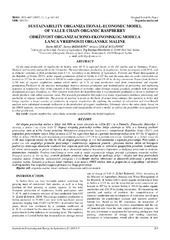Приказ основних података о документу
Sustainability organizational-economic model of value chain organic raspberry
Održivost organizaciono-ekonomskog modela lanca vrednosti organske maline
| dc.creator | Milić, Dušan | |
| dc.creator | Sredojević, Zorica | |
| dc.creator | Lukač-Bulatović, Mirjana | |
| dc.date.accessioned | 2020-12-17T22:10:54Z | |
| dc.date.available | 2020-12-17T22:10:54Z | |
| dc.date.issued | 2017 | |
| dc.identifier.issn | 1821-4487 | |
| dc.identifier.uri | http://aspace.agrif.bg.ac.rs/handle/123456789/4617 | |
| dc.description.abstract | Of the total production of raspberries in Serbia, even 90 % is exported frozen to the EU market and in Germany, France, Holland, and Austria, and partly to the US market. The total European production of raspberries, Serbia participates with 20 %, and in domestic structure of fruit production from 6.5 %. According to the Ministry of Agriculture, Forestry and Water Management of the Republic of Serbia (2017), under organic production of fruit in Serbia is 1,527 ha, and the areas that are under conversion are located on 357 ha. In western Serbia is 198.94 ha under organic raspberries and 235.19 ha during conversion. Export from Serbia is 1,500 tons of organic raspberries annual which makes up 2 % of total production (and from conventional and organic production).Producers in the practice increasingly improve primary production and modernization of processing and marketing segments of raspberries. One of the concepts is the addition of economic value through organic products, products with protected designation of origin, branding, etc. This research starts from the hypothesis that it is economically profitable to invest in facilities to obtain products with added economic value. The research presented in this paper is a model organization purchase, processing and marketing of organic raspberries. The process of analysis is given on the basis of actual data company that operates in Arilje and brings together a larger number of producers of organic raspberries. By applying the methods of calculation and Cost-Benefit analysis were calculated economic indicators in the production of organic raspberries. Schematic shows the value chain, based on the SWOT analysis, recommendations for improvement and sustainability of such a model, as well as the possibility of its application to other production. | en |
| dc.description.abstract | Od ukupne proizvodnje maline u Srbiji, čak 90% se izvozi smrznuto na tržište EU i to u Nemačku, Francusku, Holandiju, i Austriju, a delom i na tržište SAD. U ukupnoj evropskoj proizvodnji maline, Srbija učestvuje sa 20%, a u domaćoj strukturi proizvodnje voća sa 6,5%. Prema podacima Ministarstva poljoprivrede, šumarstva i vodoprivrede Republike Srbije (2017), pod organskom proizvodnjom voća u Srbiji se nalazi 1.527 ha, a površine koje su u periodu konverzije nalaze se na 357 ha. U zapadnoj Srbiji se nalazi 198,94 ha pod organskom proizvodnjom maline i 235,19 ha u periodu konverzije. Godišnje se iz Srbije izveze do 1.500 tona organske maline što čini do 2% od ukupne proizvodnje, tj. i iz konvencionalne i organske proizvodnje. Proizvođači u praksi sve više unapređuju primarnu proizvodnju i modernizaciju segmenate prerade i plasmana maline. Jedan od koncepata predstavlja dodavanje ekonomske vrednosti kroz organske proizvode, proizvode sa zaštićenim geografskim poreklom, brendiranje, itd. Ovim istraživanjem se polazi od hipoteze da je ekonomski isplativo investirati u kapacitete za dobijanje proizvoda sa dodatom ekonomskom vrednošću. Predmet istraživanja u ovom radu je model organizacije otkupa, prerade i plasmana organske maline. Postupak analize je dat na bazi stvarnih podataka preduzeća koje posluje na području Arilja i okuplja veći broj proizvođača organske maline. Primenom kalkulativnih postupaka i Cost-Benefit analize, obračunati su ekonomski pokazatelji u proizvodnji organske maline. Šematski je prikazan lanac vrednosti, a na osnovu SWOT analize, date su preporuke za unapređenje i održivosti ovakvog modela, kao mogućnost njegove primene i na druge proizvodnje. | sr |
| dc.publisher | Nacionalno društvo za procesnu tehniku i energetiku u poljoprivredi, Novi Sad | |
| dc.relation | info:eu-repo/grantAgreement/MESTD/Technological Development (TD or TR)/31058/RS// | |
| dc.relation | info:eu-repo/grantAgreement/MESTD/Basic Research (BR or ON)/179028/RS// | |
| dc.relation | info:eu-repo/grantAgreement/MESTD/Integrated and Interdisciplinary Research (IIR or III)/46009/RS// | |
| dc.rights | openAccess | |
| dc.source | Journal on Processing and Energy in Agriculture | |
| dc.subject | organic raspberries | en |
| dc.subject | value chain | en |
| dc.subject | economic sustainability the model raspberry | en |
| dc.subject | organska malina | sr |
| dc.subject | lanac vrednosti | sr |
| dc.subject | ekonomska održivost modela | sr |
| dc.title | Sustainability organizational-economic model of value chain organic raspberry | en |
| dc.title | Održivost organizaciono-ekonomskog modela lanca vrednosti organske maline | sr |
| dc.type | article | |
| dc.rights.license | ARR | |
| dc.citation.epage | 167 | |
| dc.citation.issue | 3 | |
| dc.citation.other | 21(3): 163-167 | |
| dc.citation.rank | M51 | |
| dc.citation.spage | 163 | |
| dc.citation.volume | 21 | |
| dc.identifier.doi | 10.5937/JPEA1703163M | |
| dc.identifier.fulltext | http://aspace.agrif.bg.ac.rs/bitstream/id/3144/4614.pdf | |
| dc.type.version | publishedVersion |


